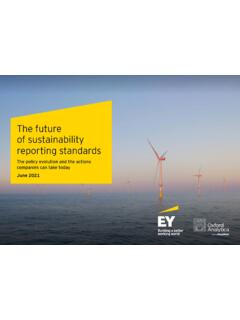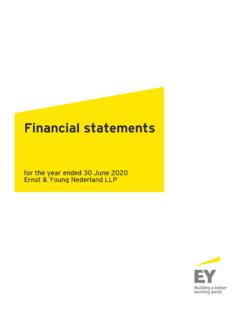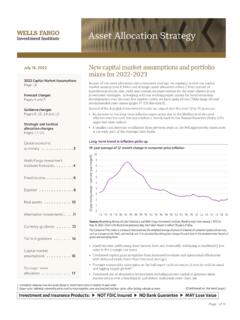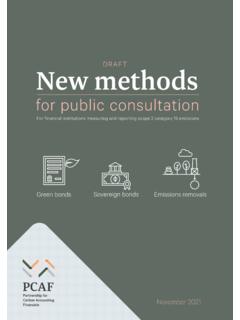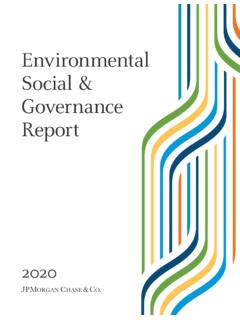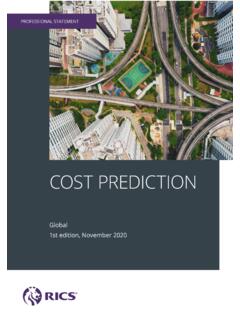Transcription of 2018 Worldwide Capital and Fixed Assets Guide - EY
1 Worldwide Capital and Fixed Assets Guide2018 PrefaceCapital expenditures represent one of the largest items on a company s balance sheet. This Guide helps you to reference key tax factors needed to better understand the complex rules relating to tax relief on Capital expenditure in 29 jurisdictions and content is based on information current as of February 2018 unless otherwise indicated in the text of the chapter. The tax rules related to Capital expenditures across the world are constantly being updated and refined. This Guide is designed to provide an overview. To learn more or discuss a particular situation, please contact one of the country representatives listed in the Worldwide Capital and Fixed Assets Guide provides information on the regulations relating to Fixed Assets and depreciation in each jurisdiction, including sections on the types of tax depreciation, applicable depreciation rates, tax depreciation lives, qualifying and non-qualifying Assets , availability of immediate deductions for repairs, depreciation and calculation methods, preferential and enhanced depreciation availability, accounting for disposals, how to submit a claim, and relief for intangible the reader s reference.
2 The names and symbols of the foreign currencies that are mentioned in the Guide are listed at the end of the is the second publication of the Worldwide Capital and Fixed Assets Guide . For many years, the Worldwide Corporate Tax Guide has been published annually along with two companion guides on broad-based taxes: the Worldwide Personal Tax Guide and the Worldwide VAT, GST and Sales Tax Guide . In recent years, those three have been joined by additional tax guides on more specific topics, including the Worldwide Estate and Inheritance Tax Guide , the Worldwide Transfer Pricing Reference Guide , the Global Oil and Gas Tax Guide , the Worldwide R&D Incentives Reference Guide and the Worldwide Cloud Computing Tax of the guides represents many of hours of tax research. They are available free online along with timely Global Tax Alerts and other publications on or in our EY Global Tax Guides app for can also keep up with the latest updates at H.
3 +1 202 327 8355 GlobalScott +1 202 327 6069 AmericasKatie +44 20 7951 3723 Europe, Middle East, India and AfricaJamie Munday +61 2 9276 9087 Asia-PacificHideaki +81 3 3506 2411 JapanEY Contacts4 Worldwide Capital and Fixed Assets Guide 2018 ContentsArgentina 06 Australia 12 Brazil 24 Canada 30 China 36 Finland 44 France 49 Germany 54 Greece 59 India 63 Italy 68 Japan 75 Kuwait 80 Malaysia 83 Mexico 915 Worldwide Capital and Fixed Assets Guide 2018 Netherlands 96 Nigeria 103 Norway 109 Portugal 114 Russia 121 Saudi Arabia 129 Singapore 133 South Africa 138 South Korea 148 Spain 156 Sweden 161 Turkey 166 United Kingdom 172 United States 178 Contacts 1866 Worldwide Capital and Fixed Assets Guide 2018EY contactGustavo Scravaglieri+54 11 4510 a glanceTerminology used by country to describe the recovery of Capital and Fixed assetsTax depreciationDoes the tax treatment follow book/statutory
4 Accounting depreciation?Yes, with respect to movable propertyRange of rates used0% 100%Depreciation method used to calculate tax deductionStraight-line, although other methods can be used with supported technical reasonsArgentina7 Worldwide Capital and Fixed Assets Guide 20181. Entitlement to claimLegal ownership is required to entitle a claim to tax Allocation of tangible Assets to tax depreciation lives and ratesSeveral tax opinions have expressed that if a movable asset is part of a building but does not constitute a sole unit with the building in terms of functionality, a different tax depreciation method applies (for example, machinery and equipment).The tax legislation only provides a 2% rate of tax depreciation per year for immovable property (except for land). Calculations must be performed on a quarterly other Assets , the tax legislation does not provide any lives or rates.
5 In general terms, accounting criteria are followed to calculate tax depreciation. However, other criteria could be adopted if there are technical reasons that support such the General Instruction (SDG ASJ-AFIP) 7/2012, the tax authorities expressed that given the lack of particular rules, in order to calculate the tax depreciation of movable Assets , it should be understood that the probable useful life refers to a reasonable estimation, and in this regard, the concepts of obsolescence and efficient useful life should be considered when making the Assets that qualify for tax depreciationSpecific fact patterns may determine different depreciation rates. The useful lives and depreciation rates indicated below are a general typeUseful life for taxType of tax depreciation methodApplicable tax depreciation rateCommentsPlant, machinery and equipment10 years (except for industrial plants, which may be regarded as buildings)
6 Straight-line method10%Other methods could be used, , units of production depreciation method or units of time depreciation method, and other depreciation rates could be applied if supported by technical yearsStraight-line method2%A higher rate could be applied in the event that a lower useful life could be , fittings or fixtures10 yearsStraight-line method10%Other methods and rates could be used if supported by technical hardware3 yearsStraight-line method33%Other methods and rates could be used if supported by technical software3 yearsStraight-line method33%Other methods and rates could be used if supported by technical yearsStraight-line method20%Other methods and rates could be used if supported by technical Capital and Fixed Assets Guide 2018 asset typeUseful life for taxType of tax depreciation methodApplicable tax depreciation rateCommentsTransport other than motor cars5 yearsStraight-line method20%Other methods and rates could be used if supported by technical cars5 yearsStraight-line method20%Other methods and rates could be used if supported by technical parks50 yearsStraight-line
7 Method2%A higher rate could be applied in the event that a lower useful life could be equipment (including office furniture and fixtures)10 yearsStraight-line method10%Other methods and rates could be used if supported by technical machinery and equipment8 yearsStraight-line method13%A higher rate could be applied in the event that a lower useful life could be Assets that do not qualify for tax depreciationTypes of assetsExplanationLandIn general, costs would be added to the value of land. The specific case should be Noteworthy itemsPreliminary costs architect fees, legal fees, planningPreliminary costs (start-up costs) can be deducted in the year in which they were incurred or amortized over a maximum term of five years, at the taxpayer s remediation removing asbestos, Japanese knotweedAccording to some interpretations, if the cost is considerable, it should be added to the cost of the land.
8 Otherwise, it could be added to the cost of the Assets to be depreciated located on such labor capitalizedNot Availability of immediate deductions for repairsThere are no rules that allow any asset to be written off in its entirety in the year of , a particular analysis of each case should be performed. If there is a reasonable justification, for example, based upon a professional opinion that may support the entire depreciation of the asset , the possibility to apply these criteria could be Capital and Fixed Assets Guide 2018 DescriptionDetailRepairs Not considered an asset . In this regard, they are deducted in the fiscal year they are of a revenue natureN /AThe tax legislation provides for the concept of repairs and also defines the concept of improvements. In this regard, repairs that may involve the simple maintenance of the asset are considered as expenditures and, as a consequence, are deductible as the other hand, improvements are disbursements that do not qualify as ordinary repairs that involve the simple maintenance of the asset .
9 They imply an increase in the value of the good of at least 20%. In addition, doctrine has expressed that, to qualify as improvement, this expense should increase the useful life of the to income tax law, improvements are not deductible as expenses in the year of accrual. They would be capitalized and depreciated over the life of the depreciation may differ from the accounting depreciation used in the financial Depreciation and calculation methodsMethods usedStraight-line is the preferred method, but the other methods can be used if supported by technical , monthly or annual tax legislation is only specific regarding the tax depreciation calculation for immovable other Assets , accounting criteria are followed or even other criteria could be adopted if there are technical reasons that support a consequence, tax depreciation could be calculated on a daily, monthly or annual basis, depending on the of acquisitionThe Income Tax Law (ITL)
10 Provides, in the case of immovable property only, that tax depreciation must be calculated on a quarterly no provisions are stated to calculate the tax depreciation for other Assets , accounting criteria or any other criteria according to each case could be adopted. The most important consideration would be to keep homogeneous of disposalA balancing change or allowance may arise to make the accurate adjustments to the Capital Assets ; the residual tax value of the corresponding asset should be deducted from the sale to use different methods for different assetsIt is not necessary, but as mentioned, the uniformity of the criteria adopted is preferable. In this regard, different methods may be used for different classes of Assets , but within the same group of Assets , it is preferable to apply the same method.



